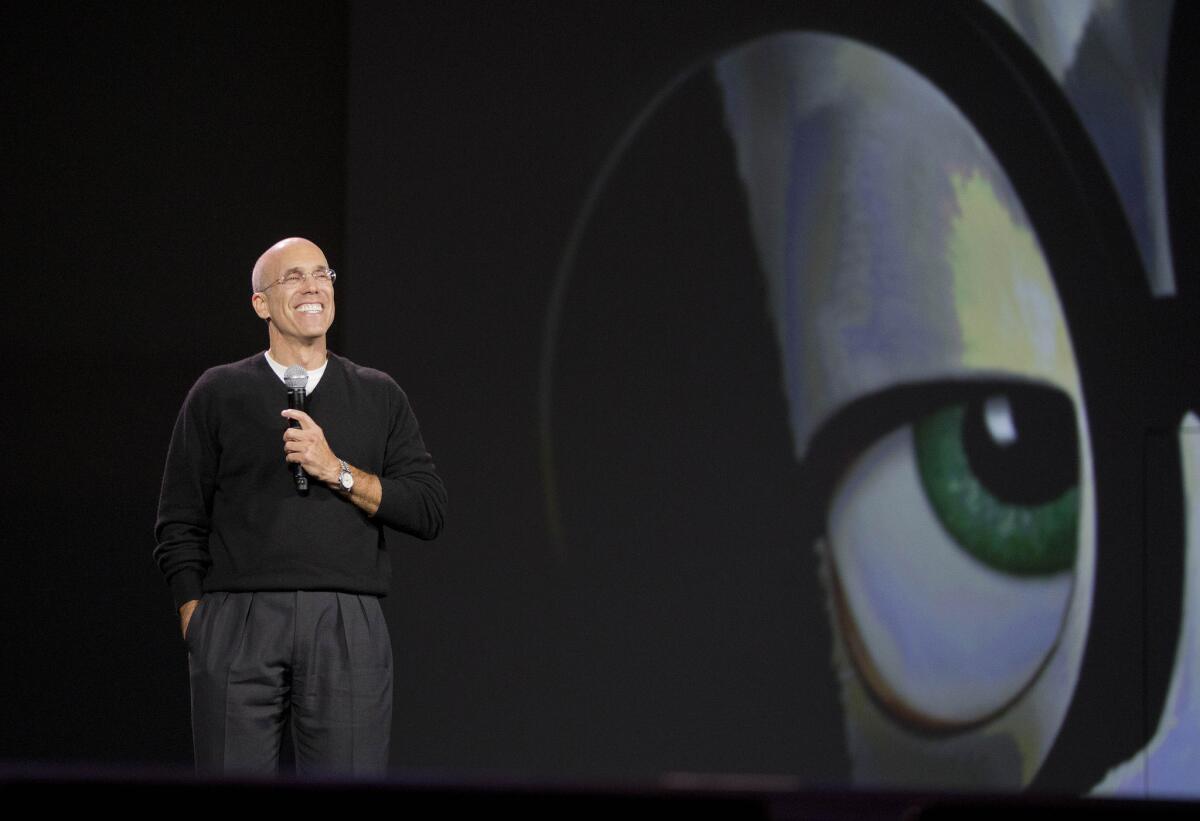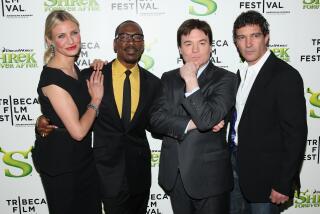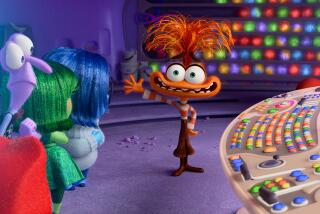DreamWorks Animation at 20

Still recovering from jet lag after a three-day trip to Australia, India and China, Jeffrey Katzenberg sat in a courtyard next to a duck pond at the Mediterranean-style campus dotted with oaks and olive trees.
The legendary Hollywood mogul, who created the animation juggernaut behind the “Shrek,” “Madagascar” and “Kung Fu Panda” movies, wasn’t eager to talk about the studio’s past.
“I’m not ready to look back yet because I have to say I feel we are so much a work in progress,” said Katzenberg, the 63-year-old chief executive of DreamWorks Animation SKG Inc. “We’ve come very far along, but in terms of being a broadly diversified family-branded entertainment company, I still think we’re in our junior years.”
Since its inception two decades ago, the Glendale company has evolved from a fledgling studio into a $700-million-a-year multimedia powerhouse with a distinct culture and expanding global footprint.
But Katzenberg is now under pressure. DreamWorks Animation is facing rising competition and restless investors after a string of box-office misfires.
The company recently reported a $43-million loss in the first quarter after taking a $57-million write-down for “Mr. Peabody & Sherman,” marking the third write-down in less than two years for the studio. After its 2013 summer hit “The Croods,” DreamWorks took a $13.5-million charge this year on its snail comedy “Turbo.”
And last year, DreamWorks reported an $87-million write-down for “Rise of the Guardians.”The flop was one reason that DreamWorks laid off about 350 employees.
The missteps have unsettled Wall Street, with investors sending the stock down 33% this year amid concerns that DreamWorks no longer dominates the animated industry the way it once did.
The company’s shares closed Friday at $23.54, up 43 cents.
DreamWorks has watched as a more crowded field of competitors has muscled in on the lucrative animation business. Universal Pictures and Warner Bros. have scored some surprise box-office hits with the “Despicable Me” films and “The Lego Movie.” And DreamWorks’ next-door neighbor and arch rival, Walt Disney Studios, is on a roll in the wake of “Frozen,” the highest grossing animated movie of all time.
Big-budget action films like “Captain America” are also competing for the same family audience.
“Before it wasn’t difficult to a make a lot of money in the animated field,” said Doug Creutz, a senior analyst with Cowen and Co. “Now, the competition is hugely intensive.... In a way [Katzenberg] was a victim of his own success. People saw how much money he was making and said. ‘Hey, we can do that.’”
Still, analysts expect much better results at the box office in June when DreamWorks releases the sequel to its 2010 hit, “How to Train Your Dragon.” They also predict long-term benefits from the company’s foray into television and other new businesses.
“Jeffrey is a visionary and I think he stands out in an industry where there are a lot of big personalities,” said James Marsh, an analyst with Piper Jaffray. “I don’t think he can be counted out at all. He’s going to figure it out.”
Katzenberg, who spent a decade reinvigorating Disney with animated hits like “The Little Mermaid” and “The Lion King” and built DreamWorks into an industry leader, has vowed to get the studio back on track.
“We have been inconsistent,” said Katzenberg, who launched DreamWorks after running Walt Disney Studios. “The only thing I can guarantee you is we are our harshest critics.”
In a recent conference call with analysts, Katzenberg said the studio was evaluating its creative process so that movies with the broadest appeal would be selected. He also said the studio would be more strategic about release dates. Average movie budgets will be lowered to at least $125 million from about $145 million.
Meanwhile, DreamWorks is rapidly trying to diversify. Katzenberg is pushing the company to be less reliant on the fortunes of animated movies by expanding into new ventures.
For instance, DreamWorks has licensed some of its well-known characters for theme parks in Russia and New Jersey. The studio is also partnering on a project to design educational computer tablets for kids, and in February launched a publishing division called DreamWorks Press.
“It makes the company stronger that there is not one leg on the stool,” Katzenberg told The Times. “Movies in the best of times are an uncertain business. We went 16 for 16 hits here. To assume that you will always do that — and now we’ve had a few that didn’t — is foolish.”
Television will play a big role in the studio’s future. DreamWorks last year signed a landmark agreement with Netflix to produce 300 hours of animation programming. Previously, the studio had only produced TV specials and series for Cartoon Network and Nickelodeon.
Under the agreement — the largest of its kind with the global streaming service — DreamWorks will produce a dozen series based on characters from its movies and those from the former Classic Media library. DreamWorks acquired Classic Media in 2012 for $155 million, gaining the rights to such characters as “Rocky and Bullwinkle,” “Lassie” and “Casper the Friendly Ghost.”
Television currently represents a small share of DreamWorks’ overall revenue — about $100 million annually. That’s expected to double by next year, and the company has hired nearly 300 full-time employees this year to work in the TV unit and other divisions.
The studio is also tapping into new entertainment platforms by deepening ties with YouTube. DreamWorks acquired YouTube teen network Awesomeness TV for $33 million last year, and in January partnered with YouTube to produce a series of daily shows called “YouTube Nation.”
DreamWorks is also making strides overseas, with much of the focus on China, where the “Kung Fu Panda” films have been very popular. Katzenberg has been at the forefront of Hollywood’s push into China, visiting the country once a month for the last two years.
The studio is working with local partners to build an entertainment and cultural district in Shanghai called DreamCenter. The center, set to open in 2017, will include a 500-seat Imax cinema, multiple performance venues and Broadway style-theaters. The area also will house Oriental DreamWorks, an animation studio that currently has 200 employees and will hire 150 more by the end of this year to work on various film and TV projects, including “Kung Fu Panda 3.”
“China in three or four years will be the No. 1 movie market in the world,” Katzenberg said. “ I just look at it as a place of opportunity.”
Even Katzenberg couldn’t have envisioned DreamWorks’ foray into China when he launched the studio in 1994 with partners Steven Spielberg and David Geffen. The animation division was spun off as a separate publicly traded company in 2004.
When it launched, the studio had only a few hundred employees. Today DreamWorks Animation has more than 2,400 employees from 30 countries. The staff includes several former employees of NASA’s Jet Propulsion Lab and Caltech, including research and development director Ron Henderson, a particle physicist who received a science and technical award from the Academy of Motion Picture Arts and Sciences this year for creating a computer program that simulates smoke, fire and explosions.
Unlike other studios, DreamWorks keeps filmmakers on staff after their projects wrap. Tim Johnson, director of the upcoming alien movie “Home,” joined DreamWorks to work on its first computer-animated movie, “Antz,” and has remained ever since.
“As opposed to having layer upon layer of executives who may not have a deep understanding of story, here I’ve got two filmmaker bosses and that’s it,” he said. “I also feel like I’m the author of my own film.”
Over the years, Katzenberg has changed his management style as the company has grown. The once famously micromanaging executive has handed over day-to-day management to others.
His executive team is led by his longtime lieutenants: Ann Daly, chief operating officer; and Bill Damaschke, chief creative officer. More recently, Katzenberg recruited Michael Francis, a former Target executive, to head up the studio’s consumer products and branding efforts.
“In the very early days of the studio, he was incredibly hands-on, like in the room all the time with filmmakers, really acting as a producer,” said Damaschke, who joined the company in 1994 as a production assistant. “He went from being a quarterback to a coach to an owner.”
Katzenberg likens his role to that of an editor who “asks the right questions.”
“I’ve been out of the day-to-day trenches of the moviemaking process for a very long time, and quite honestly our movies are the better for that,” he said.
Still, he communicates regularly with employees through a daily blog and takes pride in fostering a culture that is more Silicon Valley than Hollywood.
The studio’s perks include a full-time doctor’s office, free meals, game rooms and a college-campus-style environment with waterfalls and koi ponds.
There are yoga and sculpture classes, and an art show that enables employees to express themselves freely in ways not permitted in their everyday work. A profit-sharing plan pays bonuses to employees based on the studio’s financial performance.
Such benefits have made DreamWorks a regular on Fortune magazine’s annual list of 100 best employers. Last year it was the only Hollywood studio to make the list, ranking 12th.
Although costly, the perks have helped attract and keep talent, said Daly, who joined the company 1997.
“There’s a fundamental belief here that you need to celebrate employees as talent,” Daly said. “Today, we are still asking ‘What can we do that is creative?’ and that question permeates this place.”
More to Read
The biggest entertainment stories
Get our big stories about Hollywood, film, television, music, arts, culture and more right in your inbox as soon as they publish.
You may occasionally receive promotional content from the Los Angeles Times.











